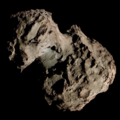 Near parabolic orbit has its perihelion above the northern ecliptic | |
| Discovery [1] | |
|---|---|
| Discovered by | J. Robinson |
| Discovery site | ATLAS–HKO (T05) |
| Discovery date | 16 December 2019 |
| Designations | |
| A10iMHA [2] CK19Y010 | |
| Orbital characteristics [3] | |
| Epoch | 12 April 2020 (JD 2458951.5) |
| Observation arc | 208 days |
| Number of observations | 1,010 |
| Aphelion | 669.1457±3.3432 AU |
| Perihelion | 0.838 AU |
| Semi-major axis | ~240 AU |
| Eccentricity | 0.99651 |
| Orbital period | ~3,720 years |
| Inclination | 73.348° |
| 31.366° | |
| Argument of periapsis | 57.498° |
| Mean anomaly | 0.007° |
| Last perihelion | 15 March 2020 |
| Earth MOID | 0.083 AU |
| Jupiter MOID | 1.026 AU |
| Physical characteristics [4] | |
| Dimensions | 1.2 km (0.75 mi) |
| Comet total magnitude (M1) | 11.9±1.0 |
| Comet nuclear magnitude (M2) | 13.8±0.5 |
C/2019 Y1 (ATLAS) is a comet with a near-parabolic orbit discovered by the ATLAS survey on 16 December 2019. It passed perihelion on 15 March 2020 at 0.84 AU from the Sun. [3] Its orbit is very similar to C/1988 A1 (Liller), C/1996 Q1 (Tabur), C/2015 F3 (SWAN) and C/2023 V5 (Leonard), suggesting they may be fragments of a larger ancient comet. [5]


